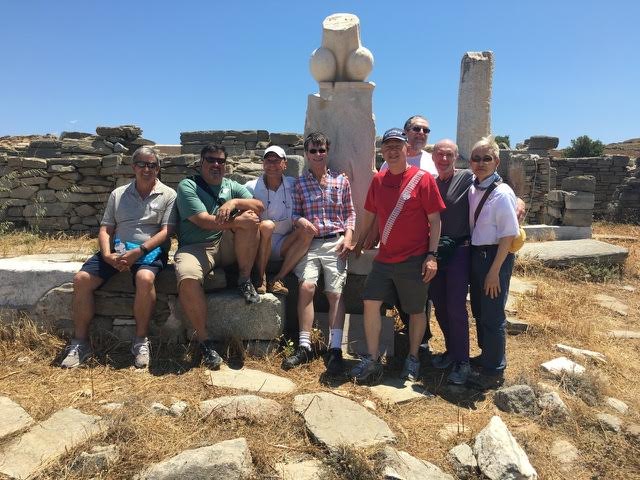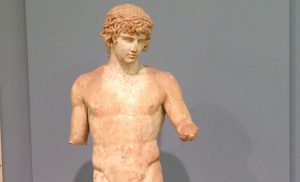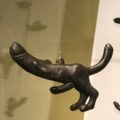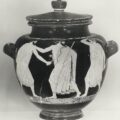In a way, this blog post is a protest against Facebook and its homophobia. I am intentionally writing a post that I will not be able to treat as an ad on Facebook, because (as you may or may not know) Facebook will not allow companies to have any nudity in their ads—even the naked chest of a statue in the Metropolitan Museum. When I first started advertising on Facebook, they claimed that art was exempt, but it wasn’t, if my experience is any guide; now they don’t even claim it is. And yes, as you may already suspect, they are stricter about this when the subject is gay. I know that directly, because I also do tours that focus on courtesans and royal mistresses, and they seem to give my “straight” ads a little leeway. With my “gay” ads, we get none: they tell me (a professor selling history tours) that I cannot advertise ‘adult products’ on Facebook. An obvious case of homophobia—and there is no-one to appeal to.
Satyrs’ Phalli
But so long as I don’t want to use it as an ad on Facebook, on my blog I can show you all the obscene pictures I want–such as this one of the Oscar Wilde Tours gay history and art tour of Greece, posing in front of one of the row of phallus statues at the temple of Dionysus on Delos. I think these phallus statues are pretty interesting for a modern viewer. They are one of the things from the ancient world that no-one in the modern world would make: a row of statues of erect penises in front of a temple. I.e., they show us ancient attitudes very unlike our own, in this case the view of the erect penis as a talisman against the evil eye and a symbol of fertility. They also help us answer a question I keep being asked: why the penises in ancient Greek statue are generally smaller than average real penises. As I said to the last journalist who called for my expert opinion on this very important matter (http://qz.com/689617/why-do-greek-statues-have-such-small-penises/), not all penises in Greek art are small. The penises of heroes and athletes are small; the penises of Satyrs and orgiasts, i.e. the worshiper of Dionysus, are over-sized. Thus I think we can see that for the Greeks, penis size was symbolic: large ones symbolized wildness, small ones self-control. Again this is different from (if no sillier than) modern attitudes, and therefore interesting.
The statues also bring me back to the issue of modern prudishness. The phalli are probably the best known archaeological remain on Delos. Yet when I went to look at them this spring, something amazing occurred to me: that I’m always alone when I go to look at them—though they are just fifty yards from the (excellent) Delos museum. What I realized is that the tours of Delos don’t include them! They spend three hours showing people Delos, take them all around the island, and leave out the most famous thing, because they are too prudish to talk about a phallic statue. And consequently most visitors never find them.
In fact, you might say this is why Oscar Wilde Tours exists: to bring the sex back into the story. And Greece is a place where the history of sex is particularly hidden behind a veil of Christian prudishness—even more so of course when the sex in question is same-sex.
Antinous
One of the passengers on our Greece tour told me about a great example of this. He and his partner wanted to buy a bust of Antinous, the Roman Emperor Hadrian’s boyfriend and a common subject in Roman art. They found one in the shop at our hotel in Delphi, where indeed there were also two photos of Delphi’s own statue of Antinous—probably the most beautiful of all images of him—in the lobby. Hadrian and Antinous’ relationship is extremely interesting. We know little about Antinous’ life, but after he died at 19 by falling (jumping?) into the Nile, Hadrian had him declared a god, and the large number (over 100!) of surviving images of him testifies to the success of this divinization. Here again of course the multi-faceted contrast with the modern world catches one’s attention, but I think this is interesting even in an ancient context, as no other Roman emperor gave a boyfriend such an important role in his public life (though many had one or more). I could go on about my theories, but it fits in with this post that despite the inherent interest of the relationship, and the relatively abundant evidence for it, there is almost no scholarship about it. And the Greeks…. Our hotel owner told my passenger the following: Antinous was Hadrian’s right-hand man (obviously untrue, since as the statue makes clear, he was an adolescent during their relationship); he committed suicide (which I regard as likely), but we don’t know why. Well, if he in fact committed suicide, I would argue that he probably did so because at 19 he was over the hill, by ancient Greek standards, even perhaps losing the emperor’s attention. The ancient Greeks customarily had relationships between adult men and adolescent boys, but these were supposed to end when the boy reached 18. This must have been a shock for the boy: if as a teenager you have got most of your adult approval from your adult lover, losing it at 18 can not have been easy. But a typical ancient Greek boy had many things to look forward to: coming of age ceremonies, years as a cadet, perhaps an early marriage—and eventually, a life as a citizen and soldier, with boy-loves of his own, and perhaps a life-long deep if non-sexual relationship with his former lover as well. But what of Antinous? The emperor’s boy could hardly go back to his city and become a cadet. What did he have to look forward to as a mature man?
Anyway, my point is just that modern Greeks have to lie about all of this, just as Facebook won’t let me put the gorgeous Delphi Antinous in an ad. Homophobia is still with us, in practical ways and in intellectual ways too. The gay past is constantly shoved under the rug and lied about, from Greek souvenir shops to American boardrooms. Which (again) is why Oscar Wilde Tours exists, to uncover the gay past, both because it’s simply interesting and because it validates same-sex relations in our own culture. Interested in fighting against intellectual homophobia (while having fun)? Check out our tours. This year’s Greece tour is already over, but there are still gay history and art tours of London and Paris in August and Italy in October, plus tours of NY and the Metropolitan Museum.
https://www.facebook.com/events/1561510334148668/











